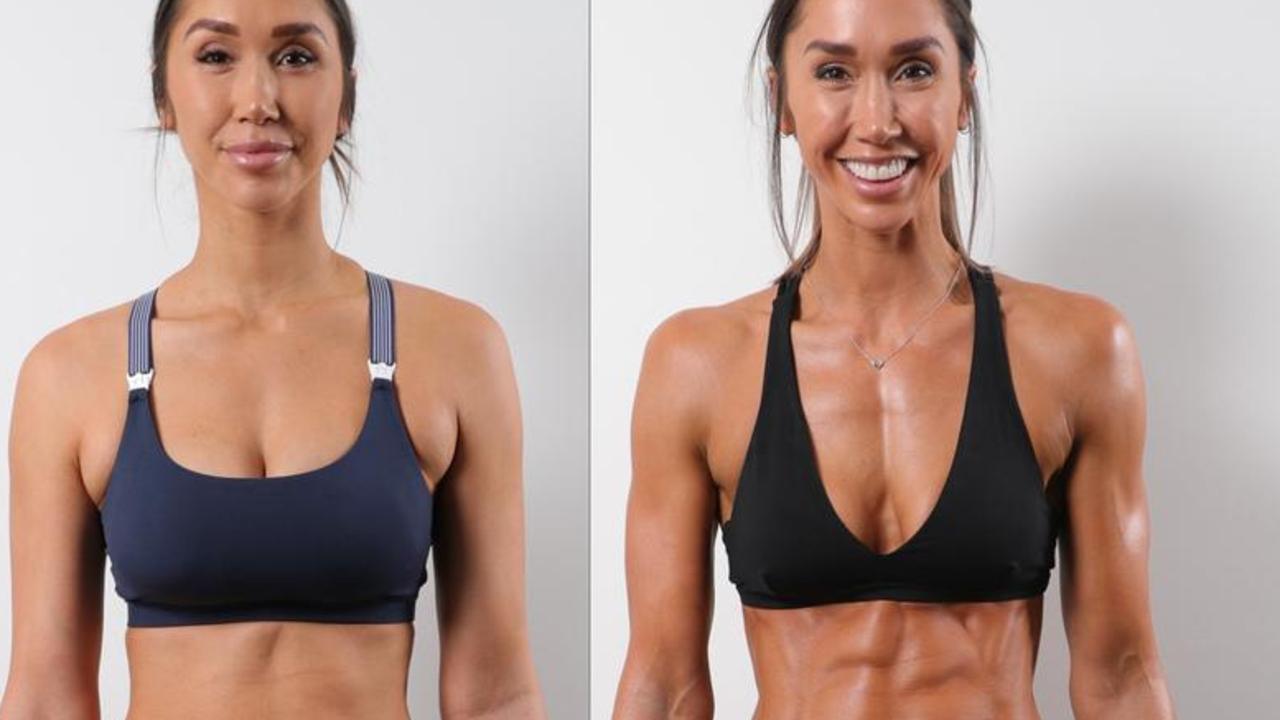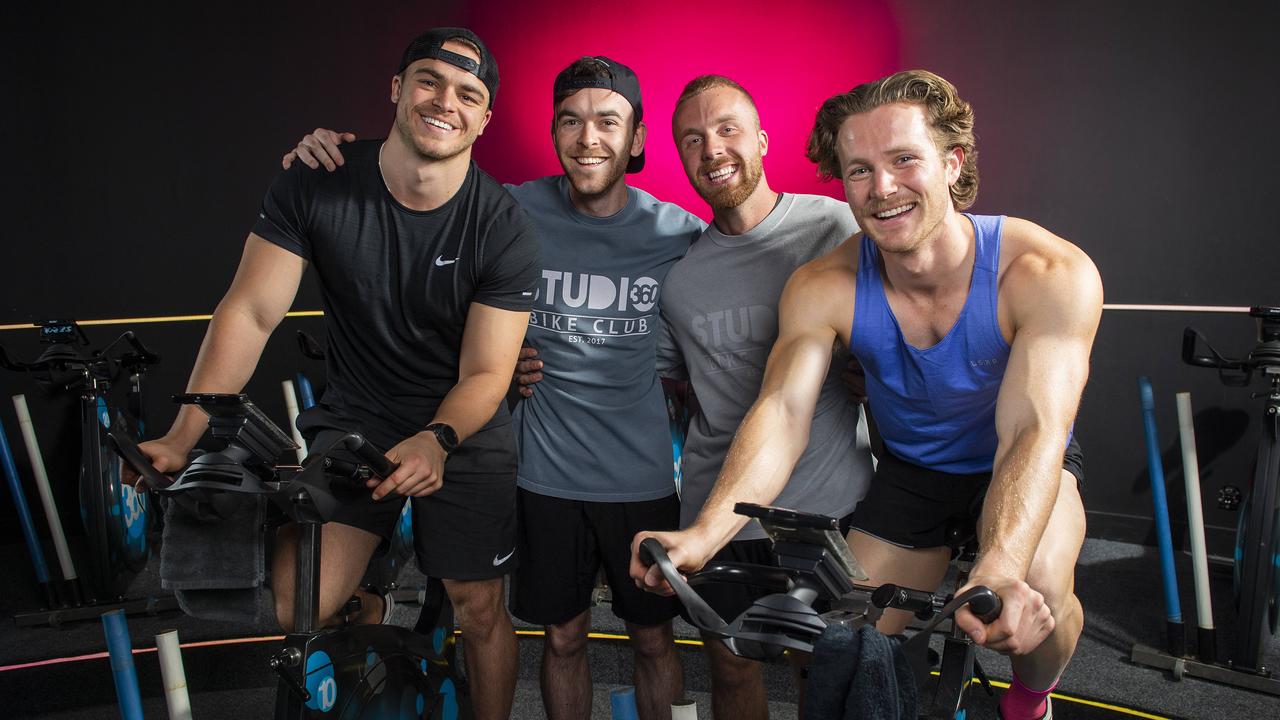How to burn more fat while exercising: Boosting your workout
Lifting weights before cardio can enhance benefits but it’s not the only way to get more bang for your buck. Here’s what experts recommend.
Workouts
Don't miss out on the headlines from Workouts. Followed categories will be added to My News.
Fat jabs aside, losing body fat requires concerted effort.
Exercise alone will not shift excess pounds – a diet and workout combination has the greatest effect – but there are ways in which we can maximise fat-burning at the gym.
Tiny tweaks to exercise and fuel intake can make a small but meaningful difference over time and the latest strategy is to switch the order of your workouts to burn more fat.
Personal trainers have debated for decades whether it’s best to hop on the treadmill, rowing machine or cross trainer for cardio before or after lifting weights.
Now a study by exercise scientists in China, published in the latest issue of the journal of Exercise Science and Fitness, provides evidence that may settle the argument for good.
Dr Zhixiong Zhou, a researcher at the Capital University of Physical Education and Sports in Beijing, and his colleagues recruited 45 overweight men aged 18-30 and asked them to follow one of three approaches for 12 weeks.
Two groups were given fitness trackers to monitor their daily steps and were prescribed three 60-minute workouts a week, the only difference being the order in which they completed their gym session.

One group of men did the 30-minute indoor cycling part of their training session prior to the strength training – a mix of weighted bench press, dead lifts, biceps curls and squats – while the other group performed the same workout the other way around.
A third control group stuck to their usual daily habits.
After three months, results predictably showed that all exercisers lost weight and gained some lean muscle tissue.
But while the sequence of the workouts made no difference to improvements in aerobic fitness, Zhou found there were significant advantages to lifting weights first when it came to fat loss.
“Our findings suggest that resistance training optimises fat loss when conducted prior to aerobic exercise,” Zhou says.
“The sequence of exercise is therefore a pivotal factor in the process of fat loss.”
Not only did the weights-first group lose more body fat overall, they also lost more of the risky visceral fat that settles around the body’s major organs.
“Visceral fat is widely regarded as the type of adipose tissue most strongly linked to cardiovascular diseases, with its excessive accumulation being strongly correlated with numerous health issues, including hypertension, atherosclerosis and heart disease,” Zhou says. “Our findings indicated that the reduction in visceral fat was more pronounced in the resistance training-first group, implying that resistance training first may effectively reduce visceral fat.”
Why this happens boils down to the way our bodies use energy when we work out.
Intense exercise, such as resistance training, reduces the muscles’ stores of glycogen, their primary fuel source, forcing the body to rely more heavily on fat for fuel if you then move on to cardiovascular activity.

“When you do cardio first, your muscles will be less depleted of glycogen unless it is a very intense session,” says Jack McNamara, a senior lecturer in clinical exercise physiology at the University of East London.
“But the cardio first will also induce a level of fatigue that means you are probably not able to impart maximal effort when it comes to resistance training later on.”
To get the most out of resistance exercise, McNamara says that you want to be as fresh as possible to exert maximum power, lift the heaviest weights you can and complete the repetitions required.
Interestingly the weights-before-cardio group displayed other fitness advantages.
Their muscular endurance and strength were better by the end of the trial.
“Overall, there were improvements in physical fitness when weights preceded cardio, particularly in terms of enhanced muscular and explosive strength,” Zhou says.
“It implies that resistance training, when performed as a warm-up prior to aerobic exercise, offers superior preparation for the body and facilitates a general enhancement in physical fitness over time.”
Data from the wrist-worn trackers also showed that daily step count was an average 3500 steps compared with just 1600 steps for the cardio-first men. “This was an interesting aside of the new study,” says Tom Brownlee, associate professor in applied sport sciences at the University of Birmingham. “It suggests that maybe confidence and energy levels increased with the weights-first sequence and the increased step count would affect energy balance over 12 weeks, helping with fat loss too.”
It’s a fitness tweak that’s worth trying. “Our ability to burn fat is important for health,” Brownlee says. “Body fat is linked to a lot of chronic diseases that we are trying to avoid and anything that we can do to increase the positive benefits that come with fat loss is a good thing.”

However, Brownlee says it is important to note that even the latest studies show that, performed in either configuration, the exercise routine had huge benefits for health. “All exercise participants lost weight and some body fat, increased strength and aerobic fitness,” he says. “What matters is that you exercise regularly and if you prefer to do it in a different sequence, it’s better than not doing it at all.”
How else might you be able to increase your body’s fat-burning ability? Here the experts give their verdict on some other strategies.
Does it help to exercise on an empty stomach?
So called exercise-fasting – working out on an empty stomach, usually before breakfast – has attracted plenty of scientific interest and many researchers have found it can help to accelerate fat-burning.
One 2022 study at Nottingham Trent University showed that fasted exercise in the evening between 4pm and 8pm (a popular time to visit the gym) helped people to burn about 70 per cent more fat than if they worked out two hours after eating.

However, in this and other studies, fasting does negatively affect exercise performance, motivation and enjoyment.
In the longer term that may affect your willingness to stick at it.
“There is a flip side in that, because glucose is our preferred fuel, your ability to operate at a high intensity might be inhibited with limited energy supplies,” Brownlee says. “As a consequence, your training session might not be as high quality as when you eat beforehand so you might want to avoid an intense workout or trying a Parkrun for a fast time in a fasted state.”
Will creatine help your body to burn more fat?
Creatine is a substance produced naturally by the body and stored mostly in our muscles. Food sources include red meat and seafood. Its reputation as a training aid stems from the fact that the higher the muscle stores of it, the greater energy reserves they have during resistance training.
Some studies have shown that creatine supplementation in combination with weights can significantly improve body fat loss.
“Creatine helps to stave off fatigue so that you can push harder in a session, lifting an extra rep or two in the gym,” McNamara says.
“Over the long term that can impact fat-burning.”
Fat loss won’t be dramatic and will only happen if you work hard at resistance training. “It should be noted that when people start taking creatine they usually gain some weight initially,” McNamara says.
“This is because more water is stored within the muscle tissue, which typically means heavier numbers on the scales, although the gains are not body fat.”
Does a pre-workout espresso prompt fat-burning?
Caffeine is a stimulant that can provide a mental boost prior to a workout and has been shown to help people work out for longer and harder as a result. That in itself may help with fat-burning in the long term, although some researchers have suggested that caffeine has a more direct influence on body fat.
Researchers from the University of Granada reporting in the Journal of the International Society of Sports Nutrition showed that participants consuming 3mg caffeine per kilogram of body weight (equivalent to a medium filter coffee) half an hour before a morning indoor cycling session, and when in a fasted state, resulted in 11 per cent higher “peak fat oxidation” – the breaking down of fat for energy – than those who took a placebo.
When the cycling was performed in the afternoon fat-burning was 29 per cent higher with caffeine than a placebo.

“Concentrations of adrenaline in our bodies are typically higher following afternoon exercise which may have contributed to the greater effect,” says Neil Clarke, associate professor in health and exercise sciences at Birmingham City University. “And the fat-burning effects may have been increased due to the exercise being performed before eating when fat oxidation is naturally higher.”
Eating – particularly carbs – before taking a black coffee reduces the serum caffeine concentration, delaying the time to reach peak concentration in the body.
“That reduces the potential for fat-burning,” Clarke says. “The bottom line is that although caffeine might increase fat oxidation, weight loss will only occur when/if your energy expended exceeds energy intake – so it’s not a magic bullet.”
Is blackcurrant extract a fat-burning aid?
Studies by Mark Willems, professor of exercise physiology at the University of Chichester, suggest that supplements containing New Zealand blackcurrant extract (such as CurraNZ), a rich source of the plant phytochemicals called anthocyanins, could prove a “serious tool” for fat-blasting if consumed in conjunction with a regular exercise routine.
In one of his trials, published in the journal Nutrients, Willems asked a group of “recreationally active” women to do 30 minutes of brisk walking after taking a 600mg supplement of blackcurrant extract for a week. Results showed that fat-burning increased by an average of 25 per cent and by up to 66 per cent for some participants, with “greater benefit shown for people who carry extra weight in their legs”.
So it could mean goodbye to the saddlebags. A similar study in men found that the same blackcurrant extract helped to blast 6 per cent more fat after two weeks.
“All of our studies on fat-burning [with blackcurrant anthocyanins] suggest that training status and fitness levels do not affect the outcome,” Willems says. “Recent trials have shown that even ultra-endurance athletes can enhance their fat-burning with the supplement.”
More Coverage
Originally published as How to burn more fat while exercising: Boosting your workout




